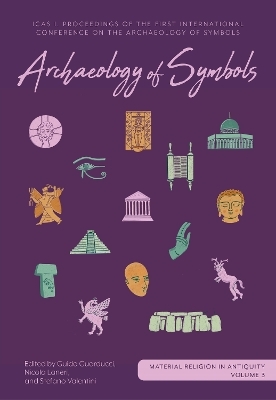
Archaeology of Symbols
Casemate Publishers (Verlag)
979-8-88857-098-2 (ISBN)
- Titel nicht im Sortiment
- Artikel merken
This third volume in the Material Religion in Antiquity series stems from the First International Congress on the Archaeology of Symbols (ICAS I) that took place in Florence in May 2022/. The archaeological process of reconstructing and understanding our past has undergone several reassessments in the last century, producing an equal number of new perspectives and approaches. The recent materiality turn emphasizes the necessity to ground those achievements in order to build fresh avenues of interpretation and reach new boundaries in the study of the human kind and its ecology. Symbols must not be conceived only as allegory but also, and perhaps mainly, as reason (raison d’être) and meaning (culture). They may be considered key elements leading to interpretation, not only in their physical manifestation but by being infused with the gestures, beliefs and intentions of their creators, created in a specific context and with a specific chaîne opératoire.In this volume a variety of case studies is offered, representing disparate ancient cultures in the Mediterranean and central Europe and the Near East. The thread that connects them revolves around the prominence of symbols and allegorical aspects in archaeology, whether they are considered as expressions of iconographic evidence, material culture or ritual ceremonies, seen from a multicultural perspective. This (and subsequent ICAS) volumes, therefore, aims to embrace all the different aspects pertaining to symbols in archaeology in a specific ‘place’, allowing the reader to deepen their knowledge of such a fascinating and multifaceted topic, by looking at it from a multicultural perspective.
Guido Guarducci is Co-director of CAMNES and supervisor of the Department of Ancient Studies at the Lorenzo de' Medici Italian International Institute, both based in Florence (Italy). He completed his PhD at the University of Reading (UK). His research interests mainly focus on the Late Bronze Age and Iron Age semi-nomadic communities of Eastern Anatolia and the South Caucasus, including the impact and interaction of the Assyrian empire in this area.117264 Nicola Laneri is Professor of Archaeology and Art History of the Ancient Near East at the University of Catania and Director of the School of Religious Studies (SORS, Florence). Since 2003, he has been the director of archaeological projects in Turkey, Azerbaijan, Iran and Iraq. He has organised conferences, panels and workshops as well as presented papers at internationally recognised meetings and institutions. He has also published more than 100 scientific articles in journals and books.64781 Stefano Valentini is Co-director of CAMNES and supervisor of the Department of Religious Studies at the Lorenzo de' Medici Italian International Institute. He was adjunct Lecturer at the Institute for Prehistoric Archaeology of the Near East, Masaryk University (Brno, Czech Republic) and at the Department of Archaeology, University of Florence. Field expert in Ancient Near Eastern Archaeology, he was field director of archaeological expedition at Tell Barri (Syria), Hatra (Iraq) and Hirbemerdon Tepe in Turkey.116267
List of contributors
Introduction: symbols in mind, symbols in matter
Guido Guarducci, Nicola Laneri and Stefano Valentini
1. Symbols in currents or strings of energy
Ian Hodder
2. Some remarks about the representation of cupping vessels (σικύα/cucurbita) in the ancient world
Ma Ángeles Alonso-Alonso
3. Abstract depictions of animals on Late Bronze swords from East Georgia
Simone Arnhold and Shorena Davitashvili
4. A comparison between Philistine/Canaanite and Judean iconography during the Iron Age II
David Ben-Shlomo
5. Reflection of a soul? Mirror-linked symbolism in early nomadic burials (Southern Urals, Russia)
Natalia Berseneva and Kseniya Margaryan
6. The physical materiality of the divine and its symbols: the case of Sarapis’ attributes in Hellenistic Egypt
Efstathia Dionysopoulou
7. Ritual and symbolism in the Matiate underground city
Durmuş Ersun
8. The architectural system of the step pyramid of King Djoser at Saqqara: its symbolic expression between social and semiotic sphere
Massimiliano Franci
9. Icon – index – symbol. Experiencing material semiotics through ancient figurines
Regine Hunziker-Rodewald and Andrei Aioanei
10. The human hand as a symbol in ancient Egyptian thought
Christos Kekes
11. Feminine symbolism in the iconography of ‘Luristan Bronzes’: a look through the Ashmolean Museum collection
Zahra Kouzehgari
12. Images and symbols of 12th-century BC pictorial pottery from Cyprus
Anna Lekka
13. Insights from the Philistine ‘Symbol-Scape’ on Philistine origins and social structure
Aren M. Maeir
14. Deer symbolism in the Kura-Araxes culture: a view from the village of Kvatskhelebi, Georgia
Sarit Paz
15. Network of symbolisms in a private tomb in ancient Thebes
María Violeta Pereyra and Mariano Bonanno
16. Is it the hairstyle? Female figurines with hairstyles in the context of the 6th millennium BC imagery of the Southern Levant
Dina Shalem, Ianir Milevski, Nimrod Getzov, Ehud Galili and Anat Cohen-Weinberger
| Erscheinungsdatum | 30.01.2024 |
|---|---|
| Zusatzinfo | 130 B/W illustrations |
| Sprache | englisch |
| Maße | 170 x 270 mm |
| Themenwelt | Geisteswissenschaften ► Archäologie |
| Geschichte ► Allgemeine Geschichte ► Vor- und Frühgeschichte | |
| Geschichte ► Allgemeine Geschichte ► Altertum / Antike | |
| Geisteswissenschaften ► Geschichte ► Regional- / Ländergeschichte | |
| Geisteswissenschaften ► Religion / Theologie ► Weitere Religionen | |
| ISBN-13 | 979-8-88857-098-2 / 9798888570982 |
| Zustand | Neuware |
| Informationen gemäß Produktsicherheitsverordnung (GPSR) | |
| Haben Sie eine Frage zum Produkt? |
aus dem Bereich


